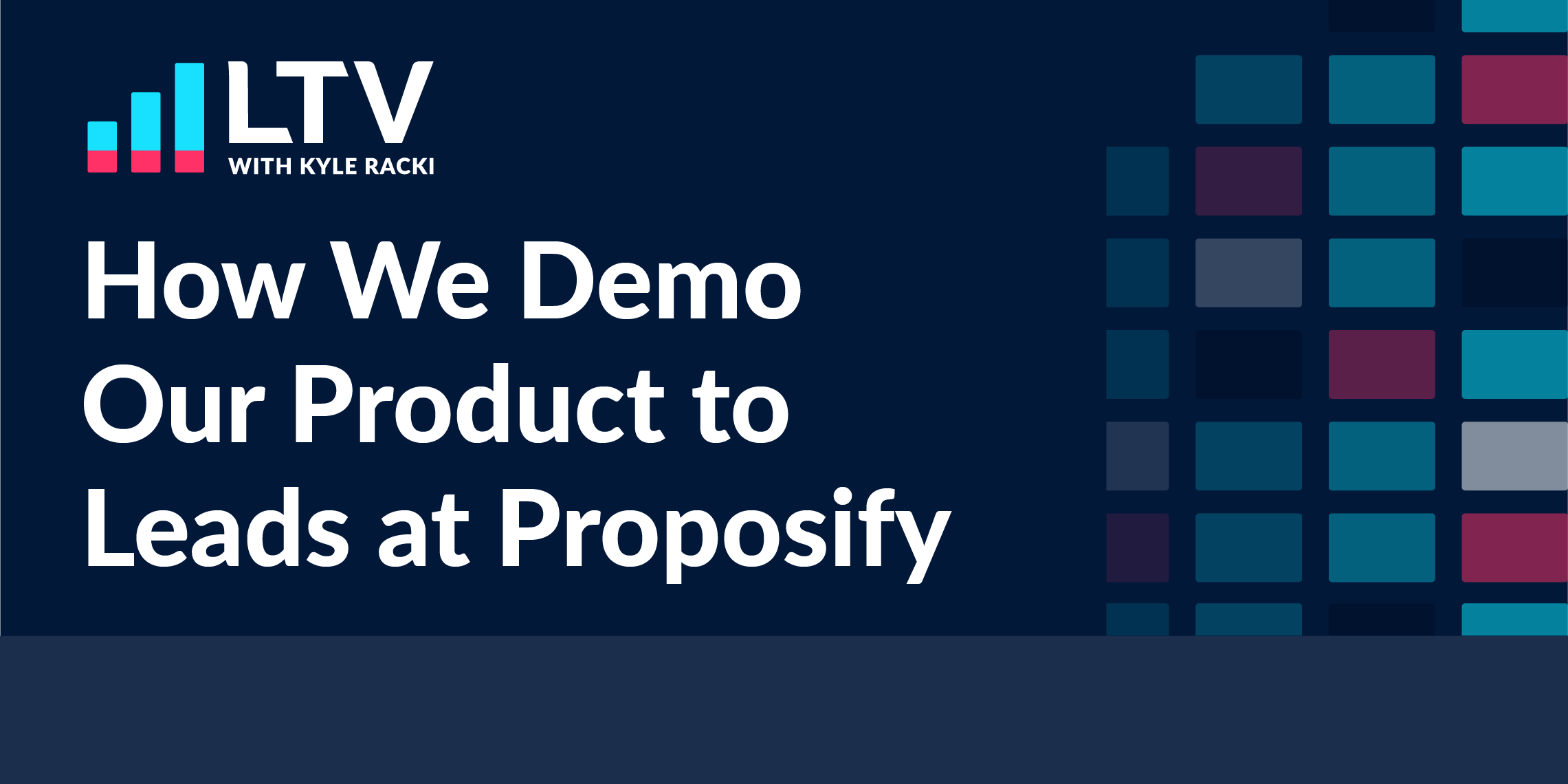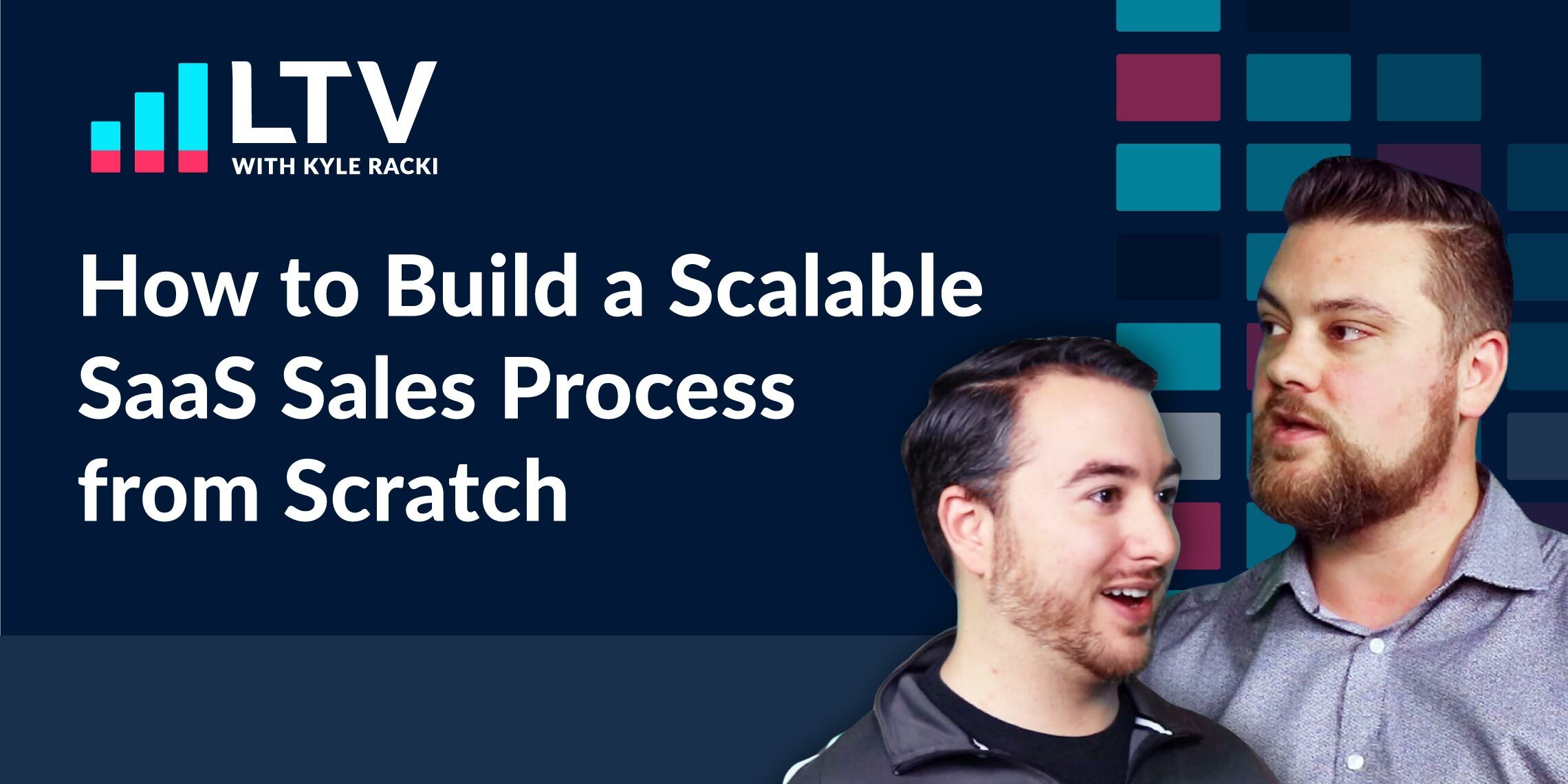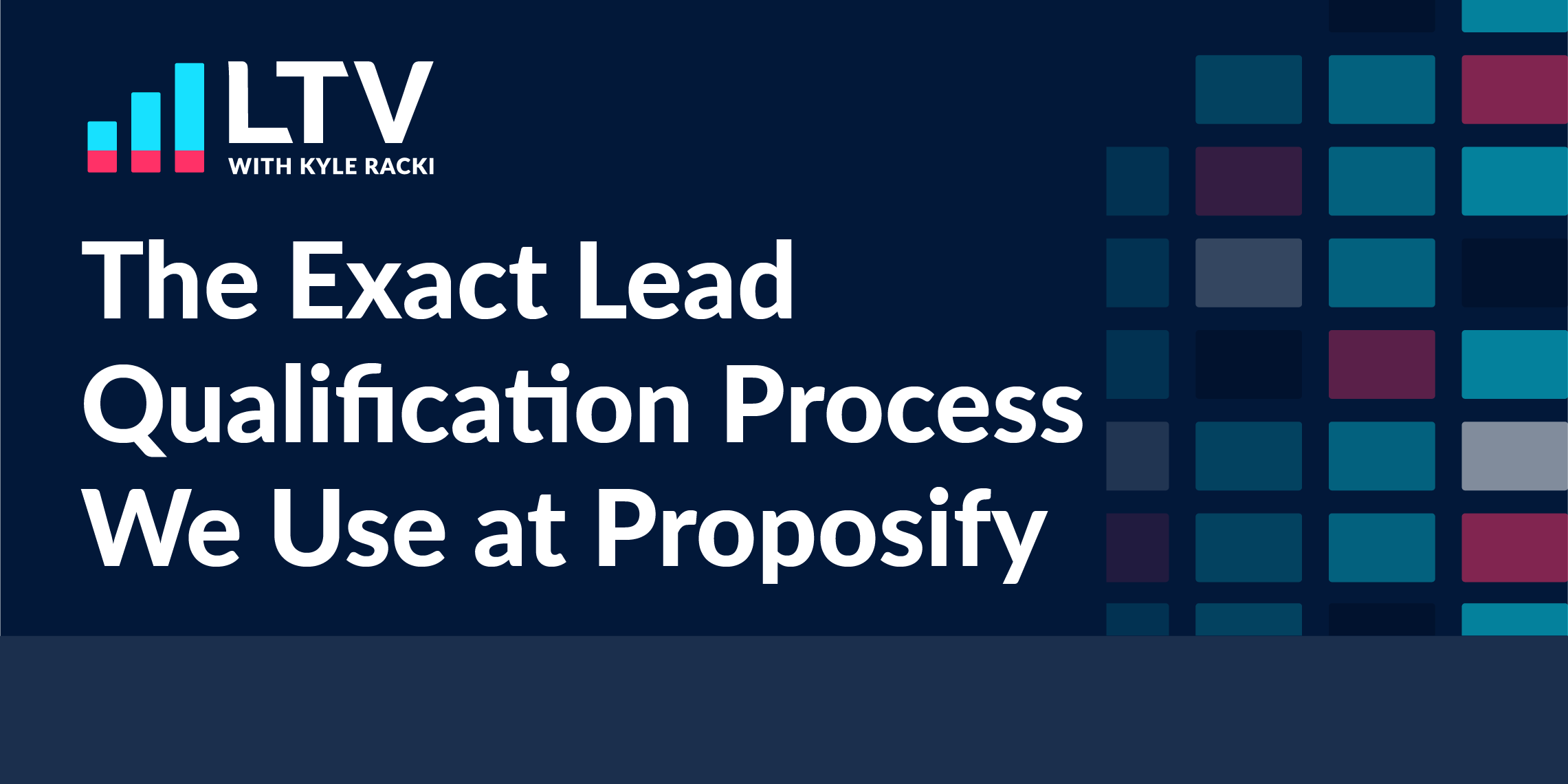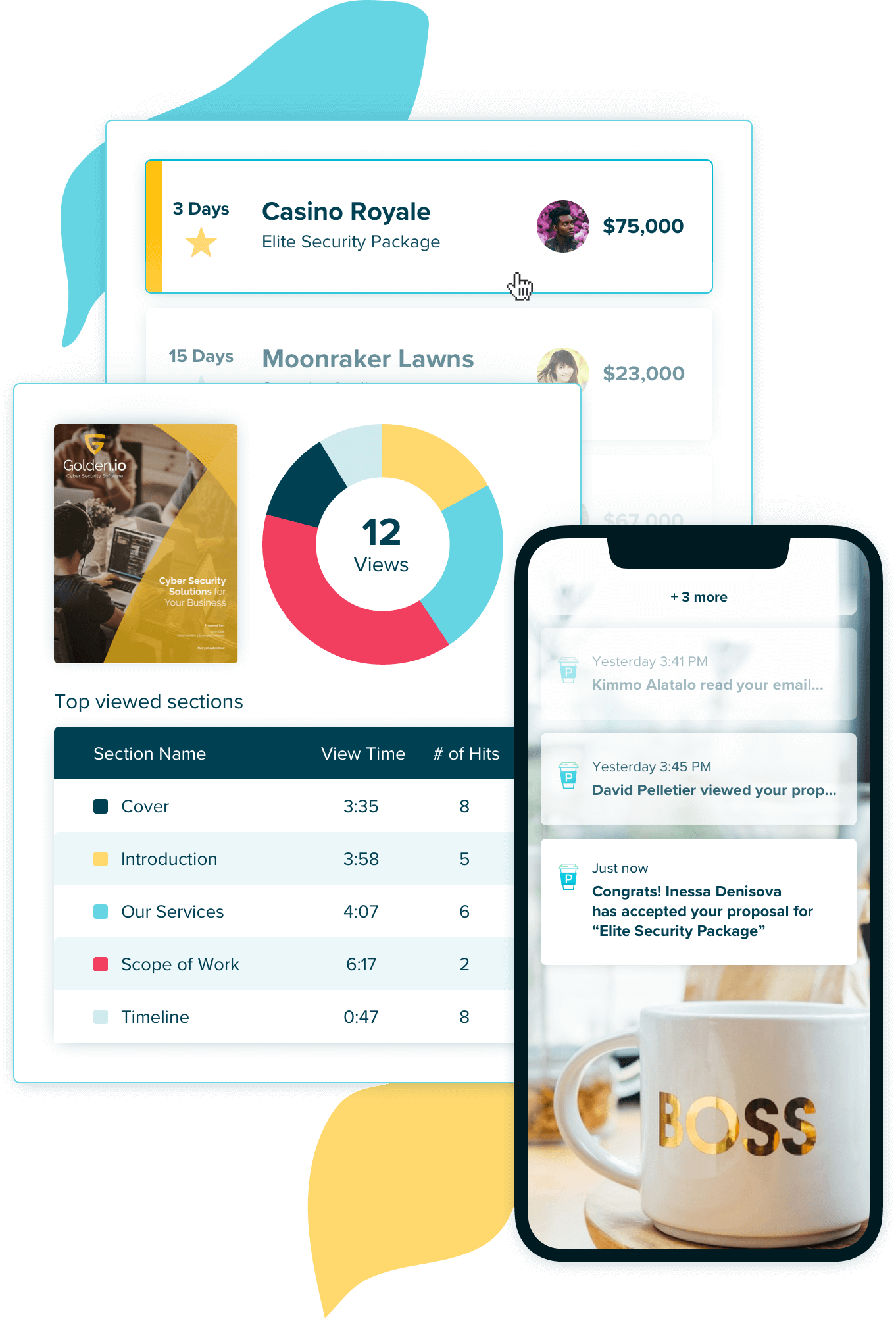When you’re building your sales process, it can be difficult to know what to say during a product demo.
It’s even harder to train reps to deliver demos with accuracy and consistency. After all, if everyone’s doing it differently, how can you know what’s working and what isn’t?
How can you optimize this critical stage of the sales process as a team?
In last week’s episode of LTV, I shared the process behind our discovery call for each new Proposify lead. Today, I’ll walk you through the next phase: the product demonstration.
This is the exact framework every Proposify rep sticks with once we’re ready to deliver a demo to a qualified lead.
Let’s dig in.
A good demo unfolds like a narrative
Much like the qualification call that precedes it, a good demo has a structure and a logical flow.
It’s a story that positions your lead as the main character. You need to get them to envision themselves using your product to solve their pain.
Remember, customers buy for their reasons, not yours.
From a practical standpoint, a good delivery hinges around these two practices:
- Show active listening techniques. Recap their pain and explain it better than they can. As I like to say, good marketing—good sales in this instance—is when your customer feels understood by you.
- Set the context. Explain your story and establish your point-of-view on the market. Demonstrate your expertise at solving problems by explaining how you’ve done it for similar companies.
It’s important to approach every demo call with a plan. At Proposify, our plan is detailed in our demo builder sheet.
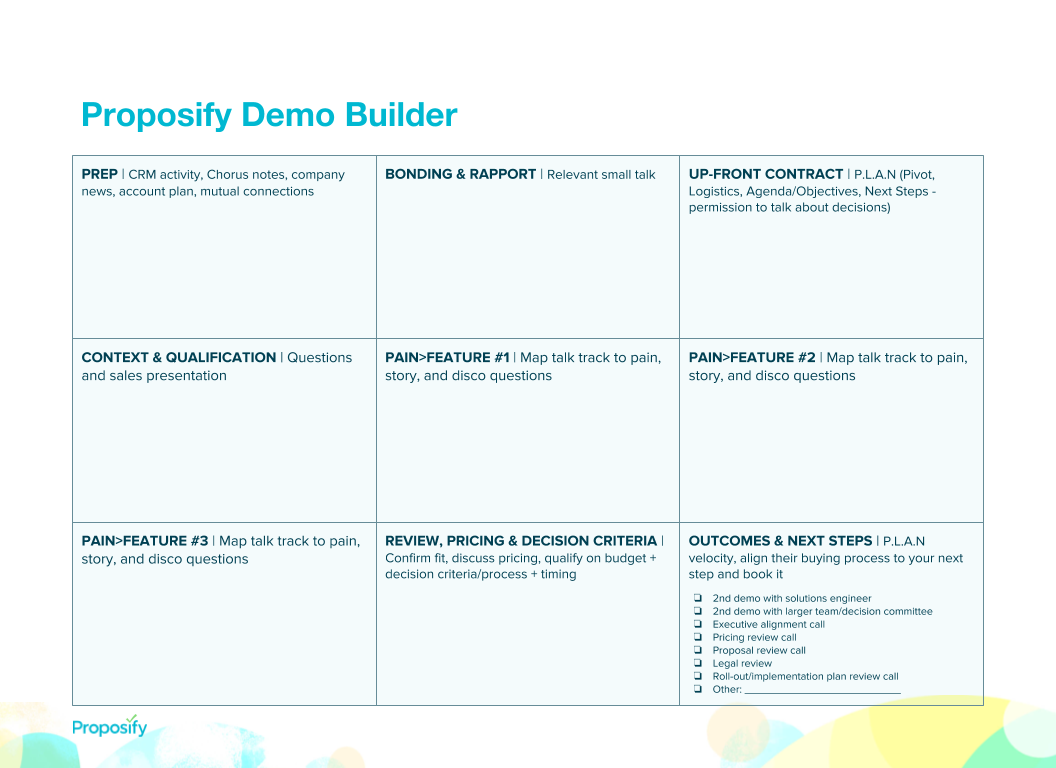
The demo builder is a framework that combines aspects of my business coach Dan Martell’s rocket demo builder with elements of the Sandler Methodology, our sales training process.
We’ve also added some of our own flair to round it out and make it unique to Proposify.
For your demo process, you’ll want to find something customized to you that acts as a blueprint that your sales reps can use to prepare for each demo they deliver.
Don’t make the mistake of throwing generic information into your demo plan and hoping it resonates with your prospect. Good demos, ones that convert, address the unique challenges your prospect is up against.
And you’ll know what those challenges are, because you’ve already asked.
Everything you need to build out a compelling product demo should have been uncovered in the discovery call. In that sense, the demo builder acts as more than just a guiding framework for reps; it allows them to isolate their prospect’s unique, self-identified pain points and position the solution to most effectively address each one.
That’s why you shouldn’t demo every lead that comes knocking. Demos are meticulously prepared presentations specific to each prospect and designed to highlight the most compelling features that solve their pain.
Once you have the demo builder filled out, you can use that information to build your recap and talk track in the demo deck.
Let’s run through each section of the demo builder and dig into how each section plays out.
Begin every demo with an up-front contract
Just like a disco call, an up-front contract at the start of the call lays out the roadmap of how things will proceed.
But you don’t want to dive into business straight away; a few minutes of relevant, sincere small talk goes a long way in fostering the rapport and connection you established in the previous conversation.
When you’re ready to get into the details, take the opportunity to establish the agenda and objectives of the call, talk about the next steps, and get the lead to confirm the pain points they identified in the discovery call.
An up-front contract puts you in control of the call and prevents the lead from hijacking the conversation and running their own agenda.
With the up-front contract is established, it’s time to dig into the nitty gritty of the call: how your solution maps to their pain and effectively solves their problems.
Let’s start with feature #1…
A compelling demo should always start with the end. For us, that is the final, polished proposal our client’s customers receive, how they would receive it.
Think about your finished product, the thing your customers walk away with, and work it into the beginning of your demo call.
At this introductory stage, our reps are showcasing how we’re differentiated against the traditional PDF. Remember, always start with the benefit/value of the functionality first instead of talking about the features.
Always make it about them, not about you.
The benefits we highlight here all map to the crown jewel of our product; a beautiful, interactive proposal that our customer’s clients can view, comment on, and sign, all right in their browser.
We cover benefits like:
- Integrated CRM functionality and easy proposal personalization without manual entry
- Allowing your clients to quickly get the info they need
- Differentiated, interactive proposals that stand out from your competitors’ PDFs
- The ability for your clients to leave comments and live chat right within the proposal
- Getting contracts to close faster with e-signatures.
Alright, now for feature #2
The next step of the Proposify demo revolves around showing how easy it is for reps to put together amazing documents.
We show off Proposify’s robust editor that allows you to customize the content and design of your proposal.
Now, there is a danger here.
We want to limit what we show in the editor, because if we get too far into the weeds the software can appear complicated.
The talk track our reps stick with is about speed and ease of use. It covers the following points:
- Allowing reps to put the right sales docs together
- Reps can quickly search for and find the content they need
- Intuitive drag and drop to build documents fast
- Automation that removes repetitive admin tasks
With any product demo, less is more. It shouldn’t be an exhaustive list of every feature. Doing that will overwhelm your lead and make selling difficult.
Instead, only show what’s relevant for their buying decision. If they buy, a customer success rep will train their team on using it. And they’ll likely do a much better job than your salespeople.
Feature #3
The final section we show in our demo is another differentiator from the traditional PDF—insights and visibility into what happens after a proposal is sent.
The talk track here is about using information to your advantage to help deals move forward. Here are some of the points we cover:
- Proposal tracking and notification—can you do that with a PDF?
- Visibility into what’s going on once a proposal is sent via an intuitive dashboard
- Making sure deals don’t go cold through automatic reminders
Waiting in the dark to learn the fate of a proposal is a common frustration many sales reps share. We show how our software eliminates the guesswork and allows sellers to track their proposals, assess their health, and, if necessary, step in to intervene and potentially save a deal at exactly the right time.
We’re extremely deliberate about how we frame the core features of Proposify. Directly singing the praises of each is a surefire way to bore your prospect and potentially come off too self-centered (me, me, me…).
That’s why we frame the benefits of Proposify as solutions to pain points that they’ve identified. Each solution is mapped to a specific feature of our software. Our prospect sees the value in our solution without us hitting them across the head with it.
Following this demo structure allows you to weave your own narrative that serves the same purpose. Craft your demo into story, the moral of which centres around how you’ll make your prospect’s life easier.
Anticipate (and encourage) a discussion
Back in 2017, call recording platform Gong crunched the numbers around successful product demo calls. Here’s what their analysis can tell us about what you should include in your next demo call.
The actual product demo itself may take up as little as five minutes out of the total call.
And demo calls are not brief, by any stretch. Successful demos actually last longer, with the most successful calls clocking in at 47 minutes in length, compared with the average demo call at just 36 minutes.
The rest of the call should be spent in discussion, with your prospect asking lots of questions. Successful demos contain 21% more speaker switches and monologues of less than 76 seconds.
But, choose your questions carefully. Successful reps asked fewer questions, but the ones they did ask were more engaging and promoted longer responses.
Don’t let your prospect run away with the conversation, either. Successful demos have a talk-to-listen ratio of 65:35 in favour of the rep, unlike discovery calls which are 46:54. Remember the up-front contract and stick to the plan.
Finally, close the conversation by solidifying the next steps. Good demos end with 12.7% more time dedicated to discussing next steps.
These numbers show us that demos that close are primarily a conversation, not a pitch.
Conclusion
Once a lead is qualified and ready for a demo of your product, don’t wing it and deliver a generic, lackluster presentation and expect them to convert.
Do your research. Come at this conversation with a thorough understanding of their pain and an ability to articulate just how much it’s holding them back. Frame your product as a solution to that pain and map these benefits to the core features of your product.
Most importantly, make sure your demos have a structure and a flow. A structured demo is an organized demo, and organized demos ultimately help close deals.
Go ahead and use the Proposify demo builder to frame your next conversation, and when you do, be sure to comment and let me know how it went.
